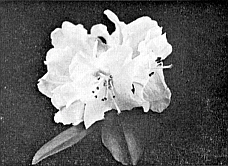QBARS - v26n2 Hybridizing With The Boothii Series
Hybridizing With the Boothii Series
Robert W. Scott, Berkeley, California
Mr. Nearing's article on the Boothii Series and its hybrids (ARS Bull. Jan. '72) has prompted me to bring together some experiences of my own in hybridizing with four species of this series: R. chrysodoron , R. leucaspis , R. tephropeplum and R. xanthostephanum .
The Series is indeed an interesting one. And the forenamed species represent a good cross section in that they cover the full range of color, flower shape, plant habit and blooming period of the Series as we know it in cultivation.
Much of my effort has centered on crossing this Series with the Ciliicalyx Subseries of the Maddenii Series. It seemed to me that to obtain desirable results from this line of breeding (such as new coloration, variety in flower shape and truss formation, as well as modification of plant habit and leaf shape) several generations of breeding would probably be required. And this is proving to be the case. A few attractive little plants have developed but with one or two exceptions the flowers have been, at their best, only promising.

|
|
FIG. 51.
[(johnstoneanum x moupinense) x chrysodoron] #1 Hadley Osborn photo |
Species other than those in the Ciliicalyx Subseries which have been used include R. calostrotum , R. chryseum , R. keiskei , R. moupinense , R. racemosum and R. spinuliferum , Of those that flowered last year the most attractive were plants of R. chryseum x 'Lemon Mist' and R. spinuliferum x 'Lemon Mist'. The former has light yellow flowers which are somewhat larger than those of R. chryseum and also has the advantage of better winter foliage than that of the species. Interest in the latter cross rests mainly on the distinctly orange coloring in the terminal cluster of small flowers.
It has been disappointing to observe the frequency of apparent sterility or paucity of seed set - as little as one or two seeds per capsule - that has shown up in the approximately forty Boothii Series crosses made. For my own very limited space this might actually be an advantage. But for others who have the room and the inclination to pursue a similar direction in hybridizing, it might prove to be a useful warning.
Out of the crosses that have flowered, only one has had sufficient quality to be named and it so happened that both parents were in the Boothii Series. R. xanthostephanum x R. leucaspis produced a plant which was named 'Lemon Mist'. Enough people have been interested in this plant so that by now it is being propagated and distributed by several sources.
At this writing, Feb. 12th, there are five R. chrysodoron hybrids that are flowering for the first time. One plant of [( R. johnstoneanum x R. moupinense ) x R. chrysodoron ] has resulted in the color break that I had aimed for. It is a yellow with a red flare. True, the yellow is lighter than desired and the flare, although fairly extensive for a lepidote, might have had more appeal if it were a more orange shade of red, But none-the-less the potential is there.
If this year's flowering doesn't produce a plant worthy of naming, then at least there well might be a fair percentage of promise.
